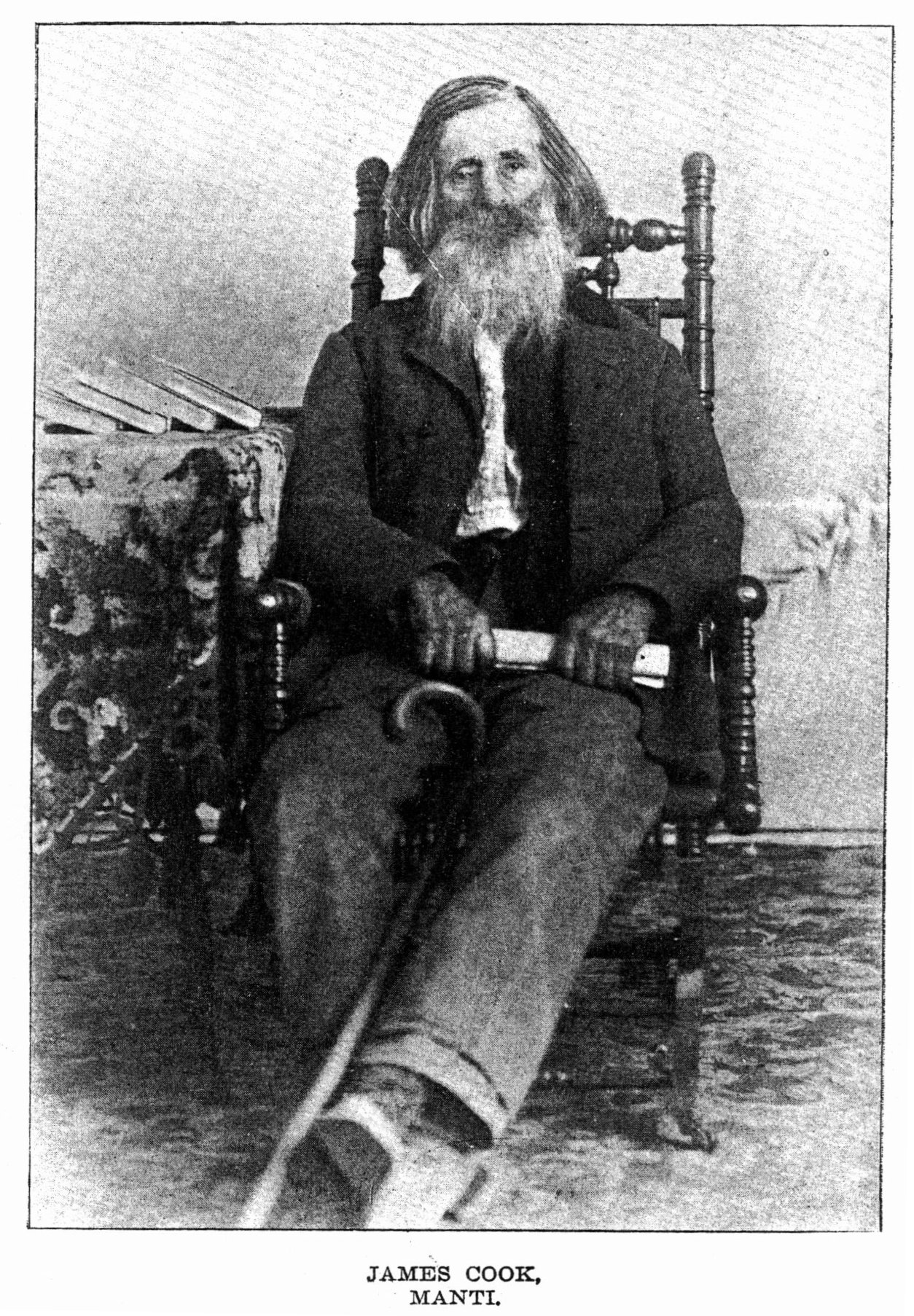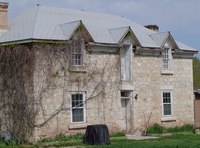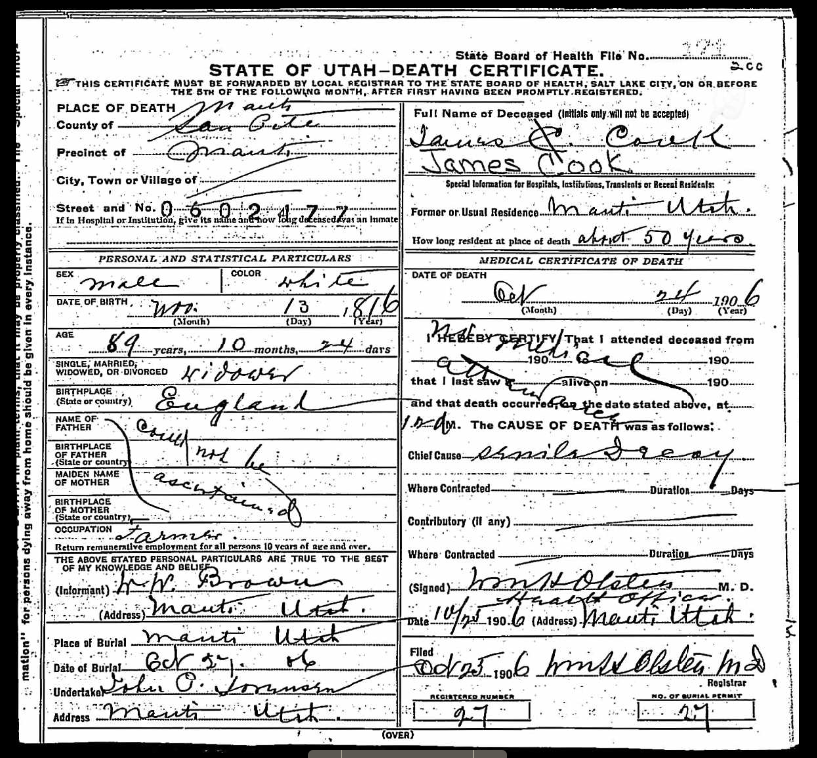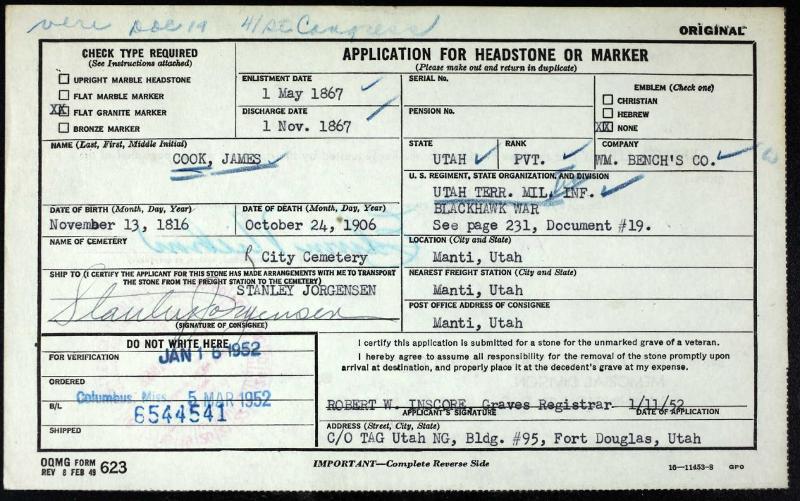James Cook 1816-1906
James Cook was born at Newport, Shropshire, England 13 November 1816 to John Felton Cook and Sarah Ann Reynolds.
James married Ann Lane at Wolverhampton, Staffordshire, England 18 December 1843. He was 27 and she was 24 years old. Ann was born to William Lane and Ann Elizabeth Bretch at Kiddymooregreen, Brewood, Staffordshire, England 4 August 1819.
According to a history of Sanpete County Ann and James had nine children (Lever). Ann was born 5 November 1844 and married William Kilshaw Barton. She died in 1901. Mary was born 4 August 1846 and died the same year. James Nicholas was born 11 February 1848 and died 1 May 1849. Henry was born 17 July 1850. He died at age 19. James Hyrum was born 10 September 1855. He married Emilie Alder and died in 1937. Brigham Daniel was born 2 April 1857, but died within the year. Alice Elizabeth Jane was born 14 July 1860 in Manti, Utah and lived 33 years. She was my great grandmother. Alice married at age 18 and had 9 children in her remaining 15 years of life. A son was born to James and Ann about 1862, but died unnamed. Finally Maude Maria Lane was born 20 February 1865. She married Christopher Hicks and died in 1940.
In February of 1851 Ann and James were baptized members of the Church of Jesus Christ of Latter-day Saints. At this time they had two children living, Ann and Henry. Two years later they joined other saints and traveled to Utah. They left Liverpool England 5 February 1853 on the ship Jersey with George Halliday as the leader of the 314 saints from England and Wales. They traveled to New Orleans, arriving 22 March 1853. The ship records show that they paid their full ticket before the ship left. Most of their fellow passengers were healthy. Only one passenger died. When they arrived near New Orleans the saints organized guards on the ship so people did not come off the land and steal their possessions (Piercy).
The saints traveled up the Mississippi River towards Nauvoo. They stopped in Keokuk Missouri to buy wagons, cattle and food for the journey. Ann and James came on the Joseph Watson Young wagon train of 1853. The wagon train, like their ship had both English and Welsh saints. Some of the saints had come from England in the “Ten Pound” company, meaning they were trying to make the whole trip on only ten pounds. Their departure date was given as the first week of June. They crossed the Missouri River about the 15th of July. The leader of the company, Joseph Young, was a newly married young man. His father-in-law was Henry Pugh, the clerk for the company. Brother Pugh wrote a detailed journal of the crossing giving a daily report of how many miles they went and other information. He noted that Sister Young was sick the whole journey. By the 31st of July Brother Young held a camp meeting and called more leaders to help him. Brother James Cook was called to be a captain of “the 3rd ten”. Each group of ten started out with three milk cows. At one time James’ ten was left to come in behind the others as they had a lack of healthy cattle to pull the wagons. Henry Pugh records in September that there was much discord in camp so the leaders met and discussed means of reconciliation and censure for those who were “making threats to use powder and ball” (Pugh). This discord may have arisen for want of food and lack of support for the newly chosen leaders. Brother Young had left the company a few days previous in hopes of making it to the valley before his wife died, but did not make it. Captain William Parry was chosen to be leader until Joseph W. Young returned after going to Salt Lake. The camp had only a few deaths, and generally were in good health.
One journal account told of a group of 500 Pawnee Indians stopping the company near their village and demanded payment before allowing them to move on. They threatened the company until each family gave up knives, kettles, or other goods. At other times Indians came into camp and stole some of their belongings.
The company encountered many other trials. Rains brought heavy mud and hard traveling. Broken equipment and difficult terrain added to their challenges. They also lacked necessities such as clean water, fire wood, and food for themselves and their animals. Although the saints were able to kill buffalo for meat a couple of times. They finally arrived in Salt Lake on the 10th of October 1853 (Adams) (Pugh).
James moved his family to Manti arriving in 1854 with only ten cents in his pocket (Lever). The following year his son James Hyrum was born. That year was considered the worst year for grasshopper invasion. In fact the next ten to 15 years were pretty bad and some called that time “the grasshopper war.” “During the grasshopper war the family of five subsisted chiefly on pigweed, one loaf of bread lasting about a month” (Lever). Some people lost three plantings of crops and others like the Cook family had to survive on pig weed, thistles and Sego Lily root. One family found that the grasshoppers didn’t bother the peas so they planted plenty and used them for flour. In time James purchased 30 acres of land and with his wife Ann’s help erected a rock and mud house with cotton cloth for the windows. This may be the same home that is still standing in Manti (James Cook home).
Following the birth of James Hyrum, four more children joined the family. Shortly after the birth of the youngest, Maude, her father James was sealed to two other women. In May of 1865 he married Hannah Massey Davenport and her daughter Maria Davenport Mackey. While in England Hannah Massey had married James Davenport, a hatter. They had five children. Three of Hannah’s children died before she joined the Church, Joseph died at age two, Elizabeth at age 18 and Ann at age 8. Hannah’s son Samuel left England for Utah when he was 15 years old. For some reason Hannah left her husband and in company with her youngest daughter, Maria, followed Samuel the next year. All three of them traveled with John R. Murdock, but Samuel in 1861 and Hannah and Maria in 1862. After moving to Manti Hannah’s daughter, Maria married John Mackey and had two children, Elizabeth and Joseph. According to church records she was sealed to him in the Endowment house 4 April 1868 and sealed to James Cook 29 July 1865. James never lived with Hannah, but supported her and her family. He had one child with Maria, which did not live (Lever).
In addition to struggling with the grasshoppers the saints in Sanpete county were contending with unhappy natives. The Indian wars of Utah lasted from 1865 to 1872. James was called to serve in the Black Hawk War in 1867. In Sanpete county the worst of the fighting was from 1865 to 1867. James served from May to November of 1867. At the time he was 51 years of age. In 1952 the family was able to put a metal tombstone on his grave for his services in that war.
In the 1870 US census James and Ann have their children, Henry, Hyrum, Alice and Maude living with them. Their first daughter, Ann had married and was living with her husband in Manti as well. The four other children of James and Ann had already died. In the same census Maria Davenport, James’ other wife, is listed as head of house living in Manti 3rd ward. Her mother, Hannah Davenport is living with her as are her two children, Elizabeth A. and Joseph. John Mackey, who Maria was also sealed to, was living next door to Maria with 20 year old Susanna listed as a house keeper and a one year old, Pheabe (sic).
By the 1880 census James (age 63) is still in Manti. He is listed as a widower with his occupation as wagon maker. Two of his wives, Ann and Maria, have passed away. Hannah is living with her son, Samuel nearby. James’ youngest daughter Maud (sic) (age 15) is still living with him as is his step-son, Joseph Mackay (sic) (age 14), Maria’s son from her first marriage. Ann died in Manti 2 November 1875 and Maria died in Manti 5 October 1879. Hannah died four years later in Manti 27 March 1884 and James not until 24 October 1906.
Sources
- Family Group Sheets in possession of the author and on Familysearch.
- History of Sanpete and Emery Counties, Utah, With Sketches of Cities, Towns, and Villages. Ogden: W.H. Lever, 1898. p. 112
- Trail Excerpt Adams, John V., Biography of John V. Adams, [1-3]. (Trail excerpt transcribed from “Pioneer History Collection” available at Pioneer Memorial Museum [Daughters of Utah Pioneers Museum], Salt Lake City, Utah. Some restrictions apply.) Accessed February 1, 2015
- Trail Excerpt Pugh, Henry, [Journal], in Journal History of The Church of Jesus Christ of Latter-day Saints, 10 Oct. 1853, 5-28. Accessed February 1, 2015
- http://historytogo.utah.gov/utah_chapters/pioneers_and_cowboys/pestiferousironclads.html Accessed February 1, 2015
- http://sanpete.com/businesses/show/2050-james-cook-home Accessed February 2, 2015
- 18 Feb 2015 - Converted to markdown by Daniel Esplin.





